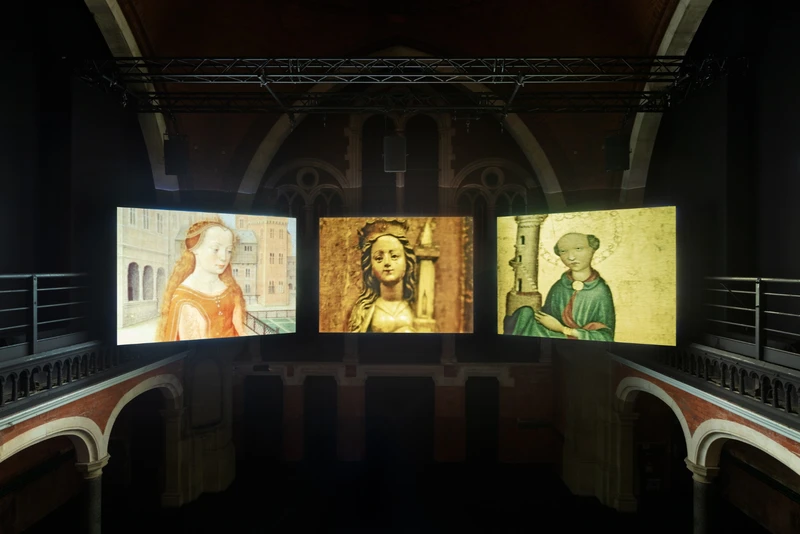Nan Goldin: Sisters, Saints, Sibyls
30 May-23 Jun 2024


The wrong things are kept secret, and that destroys people. My sister was a victim of all that, but she knew how to fight back. Her rebellion was a starting point for my own. She showed me the way.
—Nan Goldin
Gagosian is pleased to announce Nan Goldin’s Sisters, Saints, Sibyls, the second presentation of Gagosian Open, a series of off-site projects that allows audiences to experience remarkable artworks in unusual contexts. The exhibition is on view at the former Welsh chapel at 83 Charing Cross Road, London, from May 30 to June 23, 2024.
Goldin begins her film Sisters, Saints, Sibyls (2004–22) with the myth of Saint Barbara, presenting the story of the early Christian martyr as a three-channel projection that echoes the triptych format of classical religious painting. Images of Saint Barbara accompany a voiceover that describes her defiance of her parents’ beliefs, a transgression for which they tortured her. This is analogous to the real subject of Goldin’s film and underpins its visual narrative.
In 1958, Goldin’s elder sister, Barbara Holly Goldin, was sent to a psychiatric detention center at age twelve. She spent time in and out of such facilities for the next six years. Barbara was accused of “acting out, open defiance, sexually provocative behavior, association with undesirable friends, [and being] loud and coarse in speech.” Reports state that she went on dates with an older Black man, appeared to be confused about her sexual identity, and refused to shave her legs. Barbara stirred up a perfect storm of middle-class, midcentury fears around race, sexuality, and gender roles.
Goldin was a witness to the physical and psychic abuse that Barbara suffered and that her family tried to conceal. Barbara’s death by suicide in 1965, at the age of eighteen, was a defining event in Goldin’s life, prompting her to rebel against and run away from her living situation at the time, and the remainder of Sisters, Saints, Sibyls describes how she found her tribe of fellow rebels. She shows us her own experience with addiction, confinement, and self-harm, and that with living comes not only maturity and change, but also loss and pain.
For the site of the Gagosian Open presentation of Sisters, Saints, Sibyls, Goldin chose a deconsecrated church in Soho known as the Welsh chapel. The installation is a visceral, immersive environment, referencing nineteenth-century operating theaters. The piece was originally conceived in 2004, for the chapel of the Hôpital de la Salpêtrière, Paris. Salpêtrière was founded as an asylum in 1656 and was where Jean-Martin Charcot practiced his experiments on “hysteric” women. Goldin’s life’s work has always been about fighting stigma embedded in our society, addressing issues that include mental illness, addiction, and sexuality.
Sisters, Saints, Sibyls will be open extended hours during London Gallery Weekend, on Friday, May 31, and Saturday, June 1, from 10am to 8pm, and on Sunday, June 2, from 10am to 6pm. The presentation coincides with an exhibition of select early black-and-white photographs by Goldin at Gagosian, Burlington Arcade, London, from May 14 to June 22. Concurrently, Goldin will take over the Gagosian Shop with a reading room of books she has chosen, publications on her work, and a display of in-progress layouts from Heartbeat, a forthcoming nine-volume catalogue raisonné published by Steidl.
This Will Not End Well is a retrospective focused on Goldin’s moving-image work, recently on view at Moderna Museet, Stockholm (2022–23), and Stedelijk Museum Amsterdam (2023–24), and traveling to the Neue Nationalgalerie, Berlin; Pirelli HangarBicocca, Milan; and Grand Palais, Paris, over the next two years.
This fall, Gagosian will present an exhibition of Goldin’s work in New York.
Nan Goldin was born in Washington, DC, in 1953. She lives and works in New York, Berlin, and Paris. Her work is represented in major public and private collections worldwide. Retrospectives include I’ll Be Your Mirror, Whitney Museum of American Art, New York (1996–97, traveled to Kunstmuseum Wolfsburg, Germany, 1997; Stedelijk Museum Amsterdam, 1997; Fotomuseum Winterthur, Switzerland, 1997; Kunsthalle Wien, Vienna, 1998; and Národní galerie Praha, Prague, 1998); and Le Feu Follet, Centre Pompidou, Paris (2001, traveled as Devil’s Playground to Whitechapel Gallery, London, 2002; Museo Nacional Centro de Arte Reina Sofía, Madrid, 2002; Fundação Serralves, Porto, Portugal, 2002; Castello di Rivoli Museo d’Arte Contemporanea, Turin, Italy, 2002–03; and Ujazdowski Castle Centre for Contemporary Art, Warsaw, 2003). Goldin was appointed Commandeur des Arts et des Lettres by the Republic of France (2006), and is the recipient of numerous awards, including the Hasselblad Award (2007), Edward MacDowell Medal (2012), Centenary Medal from London’s Royal Photographic Society (2018), and Käthe Kollwitz Prize (2022).
About the Location
The iconic site for the Gagosian Open presentation of Nan Goldin: Sisters, Saints, Sibyls is a deconsecrated Presbyterian church in Soho known as the Welsh chapel. The Grade II–listed structure was built in 1888 by James Cubitt and served as an important religious and cultural site for London’s Welsh community before closing for worship in 1982. Since then, the landmark building has had many lives. Now home to Stone Nest, an arts organization that aims to bring exceptional and experimental art to the public, this architectural gem offers a space where audiences can encounter eclectic cultural programs. Gagosian’s temporary exhibition supports this ongoing mission.
#NanGoldin